Grilling Tips
Master the Art of Grilling Juicy BBQ Chicken
Why settle for dry, flavorless chicken when you can learn how to cook BBQ chicken to grill juicy chicken perfection? Dive into our ultimate guide designed to help you transform your backyard grilling into a culinary masterpiece. We’ll uncover the secrets behind achieving mouthwatering results every time you grill.
With our expert tips and techniques, you’ll master the perfect grilled BBQ chicken recipe that will have everyone coming back for seconds. From understanding the nuances of temperature control to selecting the best cuts of meat, and seasoning them to perfection, we’ve got you covered. Prepare to elevate your BBQ chicken game like never before!
Key Takeaways
- The safe internal temperature for chicken is 165°F.
- Preheating the grill for 10-15 minutes ensures even cooking.
- Brining chicken boosts moisture retention and enhances juiciness.
- Using a two-zone setup helps in even cooking and prevents burning.
- Bone-in, skin-on chicken pieces retain more moisture than boneless, skinless cuts.
- Marinating chicken for at least 30 minutes infuses flavors and softens meat.
- Allowing chicken to rest for 5 minutes redistributes juices, making it more succulent.
Understanding Why Chicken Dries Out
Grilling chicken can be tricky because it tends to dry out. To keep chicken moist, it’s important to know what affects moisture.
The Lean Nature of Chicken
Chicken is naturally lean, meaning it has less fat than other meats. This low fat is a big reason chicken dries out fast on the grill. Fat helps keep meat moist, so we need special bbq chicken grilling techniques for chicken.
Impact of Overcooking
Overcooking makes chicken dry and tough. When chicken is grilled too long, its proteins tighten and push out moisture. To prevent this, take the chicken off the grill when it hits 165°F. This step is key to tender chicken.
Proper Temperature Control
Keeping the grill at the right temperature is crucial for juicy chicken. Grilling chicken breasts at 400°F for about 8 minutes works well. Using a meat thermometer helps avoid overcooking. This careful temperature control is essential for juicy, tasty chicken.
Selecting the Best Chicken Cuts for BBQ
Choosing the right chicken cuts is key to a great BBQ. You might love the juiciness of chicken thighs or the crispy skin of drumsticks. We’ll look at the benefits of bone-in, skin-on pieces and how to cook chicken by part.
Benefits of Bone-In, Skin-On Pieces
Going for bone-in, skin-on chicken changes the game for your bbq chicken recipe. The bone keeps the meat moist, and the skin gets crispy. This combo is perfect for a juicy inside and a crispy outside.
Chicken thighs, especially bone-in, are great because of their fat. This fat makes the meat juicy and flavorful. Over 30,000 people have saved a recipe that shows how good these cuts are.
Choosing Between Thighs, Drumsticks, Breasts, and Wings
Each chicken cut has its own taste and texture. This makes each one a great choice for your best bbq chicken recipe. Here’s a quick look:
| Chicken Cut | Benefits | Cooking Time | Ideal Temperature |
|---|---|---|---|
| Thighs (Bone-In) | Juicy with high fat content, forgiving cooking conditions | 15-20 minutes | 160°F indirect, 165°F after resting |
| Drumsticks | Moist and flavorful, fun to eat | 15-20 minutes | 160°F indirect, 165°F after resting |
| Breasts (Boneless, Skinless) | Lean, versatile, quick cooking | 10-15 minutes | 150°F indirect, 165°F after resting |
| Wings | Crispy skin, great with a variety of sauces | 10-15 minutes | 160°F indirect, 165°F after resting |
Knowing these differences helps you cook bbq chicken to bring out its flavors. Whether you’re starting with drumsticks or trying wings, these tips will help you.
How to Cook BBQ Chicken
Learning to cook BBQ chicken is about choosing the right method, keeping the temperature right, and making sure the meat is safe to eat. We’ll cover these key points to help you make delicious BBQ chicken, whether it’s grilled or homemade.
Grilling vs. Smoking
When cooking BBQ chicken, you can grill or smoke it. Grilling uses direct heat for a quick 25 to 30 minutes. Smoking cooks it slowly, giving a deeper flavor. Think about the time and taste you want to choose the best method.
Optimal Grilling Temperature
For grilling, heat your grill to about 450°F. Clean the grate and let it get hot. Cook the chicken for 5-6 minutes on one side and 4-5 on the other. Add BBQ sauce for the last 2 minutes to enhance flavor without burning.
Using a Meat Thermometer
A meat thermometer is key for safe and juicy chicken. For breasts, aim for 160°F to 165°F. For thighs and drumsticks, go for 170°F to 175°F. This ensures your chicken is cooked just right.
| Nutrient | Amount per Serving | Recommended Daily Intake |
|---|---|---|
| Calories | 190 kcal | 656 kcal |
| Carbohydrates | 15 g | 21 g |
| Protein | 24 g | 50 g |
| Fat | 3 g | 40 g |
| Saturated Fat | 1 g | 11 g |
| Cholesterol | 72 mg | 198 mg |
| Sodium | 498 mg | 1070 mg |
| Potassium | 501 mg | 636 mg |
| Fiber | 1 g | 1 g |
| Sugar | 12 g | 16 g |
| Vitamin A | 114 IU | 741 IU |
| Vitamin C | 2 mg | 5 mg |
| Calcium | 17 mg | 49 mg |
| Iron | 1 mg | 3 mg |
Prepping Your Chicken: The Brine and Marinade
Getting your chicken ready right can make a big difference. Brining and marinating are key steps. They add flavor and keep the chicken tender and juicy.
Basics of Brining
Brining helps keep the chicken moist, so it doesn’t dry out. A simple brine of 1 cup water to 1/4 cup salt can make your chicken juicier. It’s important to chill the brine with ice before adding the chicken.
This mix will keep the chicken tender and flavorful. It’s a great way to enhance the taste of your BBQ chicken.
- Time: Brining should last between 1-2 hours for optimal results.
- Temperature: Cook brined chicken on the grill at 400-450°F.
- Volume: Brined chicken takes longer to cook because it’s more moist.
Brined chicken takes about 2 hours to prepare and cook. Let it rest for 5 minutes after grilling to keep the juices in. The safe temperature for chicken is 165°F.
Creating Flavorful Marinades
Creating the best marinades for BBQ chicken is all about the right mix. A classic marinade includes citrus juice, vinegar, oil, and spices. The acid tenderizes the meat, while the oil and spices add bold flavors.
- Time: Marinate the chicken for at least 30 minutes or up to overnight for deeper flavor.
- Balance: Acidity from ingredients like lemon juice or vinegar tenderizes, while spices add depth.
Whether you marinate for a short time or overnight, the result is juicy BBQ chicken. Brining and marinating together make your chicken a hit at any event. Remember to add BBQ sauce 5-8 minutes before the chicken reaches 140-145°F to avoid burning and get a perfect glaze.
Seasoning for Maximum Flavor
Getting tender grilled chicken is more than just cooking. It starts with the right seasoning. The spices you pick can make your BBQ chicken taste amazing. Let’s look at how to pick and use spices for the best homemade BBQ chicken.
Choosing the Right Spices
When making the perfect seasoning for BBQ chicken, balance is important. Mix heat and sweetness for a deeper flavor. Common spices include:
- Chili powder
- Garlic powder
- Onion powder
- Paprika
- Thyme
- Black pepper
- Cumin
- Cayenne pepper
- Brown sugar
These spices give BBQ its unique taste. They help make your homemade BBQ chicken delicious.
Applying Dry Rubs and Spices
Start by mixing your spices. Then, rub them all over the chicken for even coverage. This not only seasons the meat but also creates a juicy crust.
Let the chicken sit with the rub for at least 15 minutes. But, resting it for 30 minutes or more is even better. Remember, patience is key for tender, flavorful chicken.
| Spice | Quantity |
|---|---|
| Chili Powder | ¼ cup |
| Paprika | 1 tablespoon |
| Thyme | 1 tablespoon |
| Salt | 2 teaspoons |
| Garlic Powder | 2 teaspoons |
| Black Pepper | 1 teaspoon |
| Cumin | 1 teaspoon |
| Cayenne Pepper | 1 teaspoon |
| Brown Sugar | 1 tablespoon |
Using a balanced spice rub is key for tender chicken. It makes sure every piece of your BBQ chicken is full of flavor. Enjoy the delicious results of your expertly seasoned BBQ chicken!
Mastering the Grill Setup
Getting the perfect BBQ chicken starts with setting up your grill right. This step is key to making sure your chicken is juicy and full of flavor.
Preheating the Grill
First, heat your grill to about 450°F. This high heat is important for searing the chicken. It creates a tasty crust and keeps the juices inside. Make sure to preheat for 10-15 minutes to avoid hotspots that can mess up your cooking.
Creating a Two-Zone Setup
A two-zone setup is a game-changer for BBQ chicken. You need one side for direct high heat and the other for indirect lower heat. Sear the chicken on the hot side until it’s golden brown. Then, move it to the cooler side to finish cooking.
This method helps the chicken cook evenly without burning. It’s a key step to avoid dry chicken.
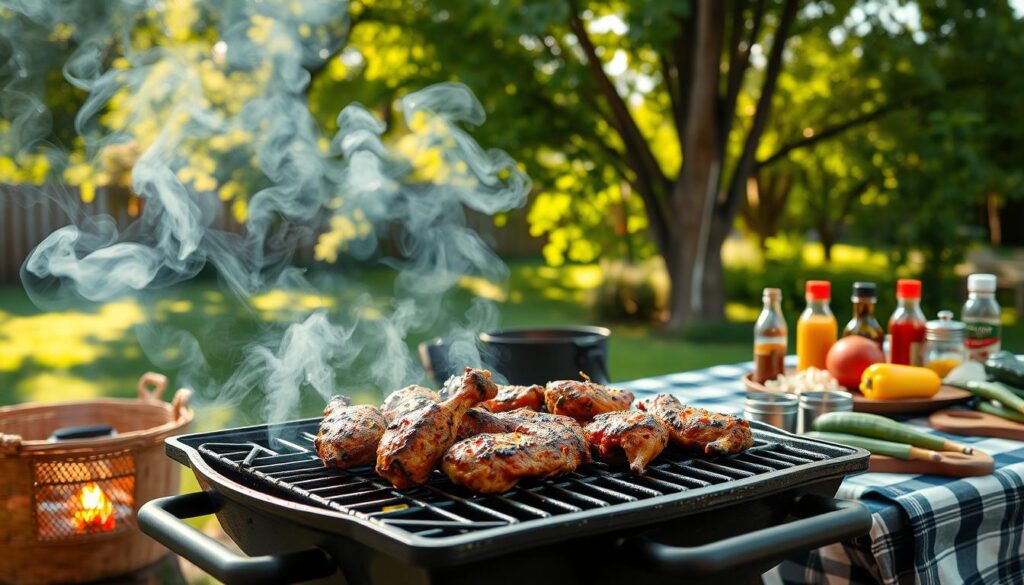
| Chicken Cut | Suggested Cooking Time | Internal Temperature |
|---|---|---|
| Boneless Chicken Breasts | Approx. 15 minutes | 165°F |
| Boneless Chicken Thighs | Approx. 20-25 minutes | 165°F |
| Bone-In Chicken Thighs | Approx. 35-45 minutes | 165°F |
| Chicken Wings | Approx. 30-35 minutes | 165°F |
Essential Grilling Techniques
Learning bbq chicken grilling techniques is key to making your chicken taste great and stay juicy. It’s all about managing flare-ups, knowing when to flip the chicken, and using the grill’s lid right. The secret to grilling juicy chicken is keeping the temperature steady and controlling how long you cook it.
Handling flare-ups is very important. If a flare-up occurs, move the chicken to a cooler part of the grill. Then, put it back once the flames die down. This way, you avoid burning the chicken while cooking it to perfection.
Flipping your chicken at the right times is also crucial. Boneless skinless chicken breasts cook for 6-8 minutes per side over medium heat. But, bone-in thighs and drumsticks need 25-30 minutes, cooked over indirect heat to stay moist.
Timing is everything in making the perfect grilled BBQ chicken recipe. Grill chicken wings for 20-25 minutes, turning them often for even cooking. Use a meat thermometer to check the chicken’s internal temperature, aiming for 165°F to keep it moist.
Using the grill lid correctly helps you get even heat, just like an oven. Preheat the grill for 10-15 minutes until it’s hot, between 375°F to 450°F. This high heat at the start seals in the juices and flavors.
By using these bbq chicken grilling techniques, you’ll have a great barbecue that everyone will love. Remember these tips, and you’ll be grilling juicy chicken like a pro every time.
The Importance of Resting Your Chicken
Resting your grilled chicken is as important as cooking it. This step is key to getting juicy and tender chicken. It makes your meal better.
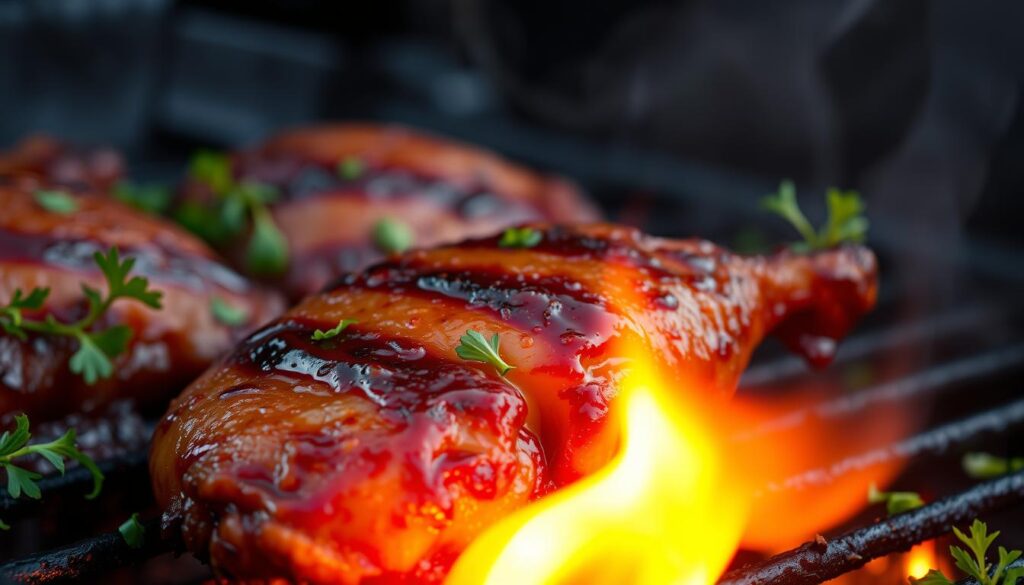
Why Resting Matters
Resting the chicken is a crucial step in grilling it right. Letting it rest for about 5 minutes helps the juices spread evenly. If you cut it too soon, the juices will run out, making it dry.
To keep it warm and even, cover it loosely with foil. This helps the chicken stay juicy.
How Long to Rest Your Chicken
For best results, let the chicken rest for about 5 minutes. This makes it juicy and flavorful. Always check that the chicken is at least 165ºF before resting it.
This ensures it’s cooked and safe to eat. Plus, it stays juicy and tasty.
Perfect Timing: When to Apply BBQ Sauce
Getting the timing right for BBQ sauce on chicken is key. Many grillers apply sauce too soon and keep basting, which can burn the chicken. To get the best results, it’s important to know when and how to apply the sauce.
Avoiding Burnt Sauces
BBQ sauces with a lot of sugar can burn easily if the heat is too high. It’s best to add the sauce in the last 10 to 15 minutes of cooking. This way, the sauce caramelizes and sticks without burning.
For juicy chicken, bake at 400 degrees Fahrenheit. Start with chicken thighs at 25 minutes before adding the first sauce layer.
Layering for a Glazy Finish
To get a glazy finish, use thin layers of BBQ sauce. Let each layer caramelize before adding the next. This builds flavor and a glossy look that’s both attractive and tasty.
After each layer, cook for 7 more minutes. Repeat this a few times for the best results. For a crispy finish, broil the chicken briefly after the last sauce layer.
Choosing the right BBQ sauce is also crucial. Look for a thick sauce that sticks well. Adding ingredients like peach preserves, garlic, and hot sauce can make your chicken extra flavorful. The right sauce and timing are essential for perfect BBQ chicken.
Quick Tips for Preventing Dry Grilled Chicken
Grilling chicken right is all about the right techniques and practices. Here are some tips to make your grilled chicken moist and delicious every time.
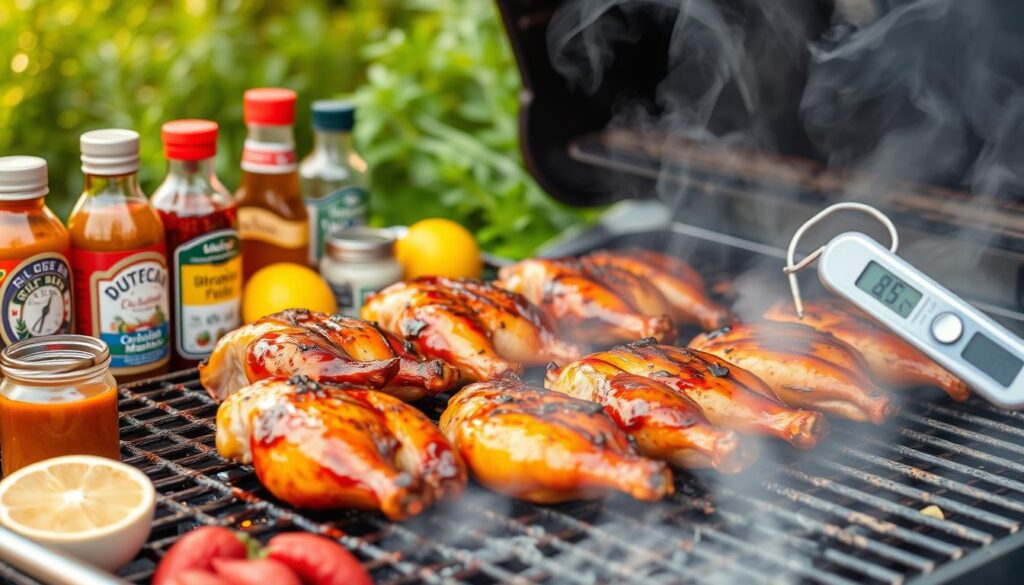
- Preheat the Grill: Always preheat your grill to high heat, approximately 375-400°F (190-204°C), to ensure proper searing and prevent sticking.
- Even Thickness: Pound chicken breasts to an even thickness of ½-inch to ensure uniform cooking and prevent dry, overcooked edges.
- Proper Marination: Marinate your chicken for at least 4 hours, or preferably overnight. This deeply infuses flavors and helps with how to prevent dry grilled chicken.
- Brining: Brining your chicken for a minimum of 30 minutes forms a moisture-retaining shield, making it more forgiving to slight overcooking.
- Indirect Grilling: Utilize a two-zone cooking method by starting with high heat searing and finishing the chicken on medium-low or indirect heat.
- Internal Temperature: Always monitor the internal temperature with a meat thermometer. Remove chicken from the grill at around 160°F, allowing it to rise to the recommended 165°F while it rests.
- Resting Time: Let the chicken rest for 3-4 minutes post-grilling. This redistributes the juices, ensuring a moist and flavorful bite.
- Avoid High Heat: Grill chicken on medium heat to prevent external charring and internal undercooking.
- Basting: Basting chicken with flavorful liquids during grilling enhances both moisture and taste.
- Grilled Vegetables: Cooking vegetables like zucchini and bell peppers alongside chicken can increase the moisture content in the cooking environment.
- Beer Can Method: For whole chickens, the beer can method can steam the chicken internally, resulting in moist meat.
- Seasoning: Salt your chicken before grilling to seal in moisture and enhance flavor as it fades during cooking.
- Even Cooking: Allow marinated chicken to rest at room temperature for 15-30 minutes before grilling for more even cooking.
- Grill Setup: Create a two-zone setup for optimal grilling by searing on high heat first and finishing on indirect heat to retain moistness.
| Step | Description |
|---|---|
| Grill Preheat | High heat, 375-400°F (190-204°C). |
| Even Thickness | Pound to ½-inch. |
| Marination | Minimum 4 hours. |
| Brining | At least 30 minutes. |
| Grill Method | Two-zone cooking. |
| Temperature | Remove at 160°F, rest to 165°F. |
| Resting Time | 3-4 minutes. |
| Avoid High Heat | Use medium heat for even cooking. |
| Basting | Enhances moisture and flavor. |
| Grilled Vegetables | Increases moisture in the environment. |
| Beer Can Method | Steam whole chicken internally. |
| Seasoning | Salt for moisture retention. |
| Room Temperature | Let rest for 15-30 minutes before grilling. |
| Grill Setup | Sear on high, finish on indirect heat. |
With these tips, you can make your BBQ chicken moist and flavorful. Mastering how to keep chicken moist on the grill and how to prevent dry grilled chicken will impress your guests with every juicy bite.
Delicious BBQ Chicken Recipes
Make your next grilling session unforgettable with these tasty BBQ chicken recipes. Whether you’re looking for a great BBQ chicken recipe for family gatherings or a simple one for weeknights, these dishes will impress. From BBQ chicken breast to smoky wings and flavorful kabobs, each recipe offers a delightful experience.
Classic BBQ Chicken Breast Recipe
A perfectly cooked BBQ chicken breast is unbeatable. To keep it juicy, brine the chicken for 2 to 4 hours. This step helps keep the chicken tender while grilling. Cook the breasts on medium heat for 6-8 minutes per side. Always check the internal temperature with a meat thermometer to ensure it reaches 165°F.
Smoky BBQ Chicken Wings
Smoky BBQ chicken wings are great for any event. Grill the wings for 20-25 minutes, turning them often for even cooking. For a deep smoky flavor, finish them with indirect heat until they reach 165°F. Marinating the wings for at least 2 hours will boost the flavor.
BBQ Chicken Kabobs
BBQ chicken kabobs are fun to make and loved by all. Make sure the chicken is marinated for at least 2 hours. This keeps it moist, even with small pieces. Grill the kabobs on medium-high heat, turning them every few minutes for even cooking. Aim for an internal temperature of 165°F for safe and tasty kabobs.
- Brine chicken for 2-4 hours to maximize moisture retention.
- Use a meat thermometer to check the internal temperature regularly.
- Apply a combination of rubs, marinades, and injections for enhanced flavor and juiciness.
| Recipe | Grilling Time | Marination Time | Internal Temperature |
|---|---|---|---|
| Classic BBQ Chicken Breast | 6-8 minutes per side | 2-4 hours brining | 165°F |
| Smoky BBQ Chicken Wings | 20-25 minutes, frequent turning | 2+ hours marinating | 165°F |
| BBQ Chicken Kabobs | Regular turning every few minutes | At least 2 hours marinating | 165°F |
With these recipes, you’re on your way to becoming a BBQ chicken master. Whether it’s the classic BBQ chicken breast, smoky wings, or flavorful kabobs, each dish is a hit. They’re the best BBQ chicken recipes you and your guests will love and remember.
Serving Ideas and Pairings
Enhancing your BBQ chicken experience is easy with the right accompaniments. Choose complementary side dishes and sauces to elevate the flavors. This makes your meal unforgettable.
Complementary Side Dishes
Pairing BBQ chicken with the right side dishes is key. Creamy macaroni salad, tangy vinegar coleslaw, and hearty baked beans are popular choices. For a fresh twist, try grilled vegetables or a tomato cucumber salad.
Busy hosts can opt for quick sides like Instant Pot Mac & Cheese or peach caprese salad. These are perfect for last-minute preparations.
The variety of BBQ chicken side dishes is vast. There’s something for everyone. Here are some stats on popular sides and their prep times:
| Side Dish | Preparation Time |
|---|---|
| Instant Pot Mac & Cheese | 30 minutes |
| Peach Caprese Salad | 30 minutes |
| Grilled Peach and Burrata Salad | 20 minutes |
| Baked Beans | 40 minutes |
| Watermelon Basil Salad | 15 minutes |
| Crispy Baked Avocado Fries | 30 minutes |
Best Sauces and Toppings
The right sauces and toppings can elevate your BBQ chicken. Try a tangy vinegar-based BBQ sauce, a sweet and spicy glaze, or a rich bourbon sauce. For a twist, serve with Greek yogurt tzatziki or mango salsa.
Combining traditional and innovative dishes and toppings will please your guests. From creamy mac and cheese to crispy avocado fries, the right pairings are key.
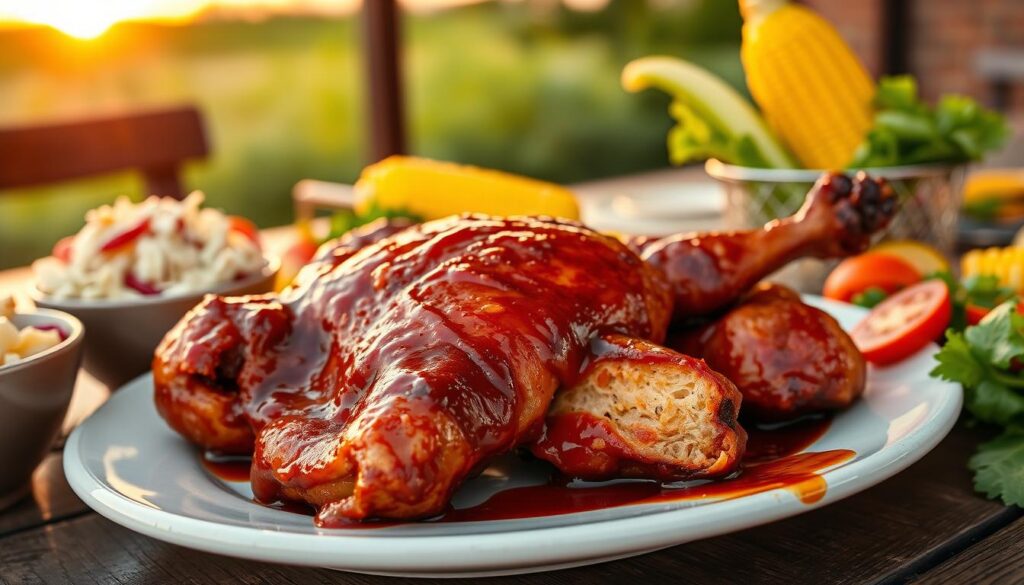
Conclusion
Now you can make juicy BBQ chicken like a pro. This guide showed you how to make sure your chicken is always tender and tasty. You learned about choosing the right cuts, brining, and marinating.
These steps are key to a great grilled BBQ chicken recipe. We also talked about the benefits of bone-in, skin-on pieces and the importance of resting the chicken after grilling.
By following these tips, you’ll impress everyone with your grilling skills. Try different marinades and rubs, like Laajawab Rocky Smoky Chicken Rub. Also, learn to use medium-high heat and a meat thermometer.
Whether you’re making BBQ chicken breasts, wings, or kabobs, the results will be amazing. Pair your chicken with sides like coleslaw, potato salad, or grilled veggies for a full meal. Now you know how to make BBQ chicken that’s both tasty and memorable. Happy grilling and enjoy your delicious BBQ chicken!
FAQ
How can I prevent chicken from drying out on the grill?
To keep chicken moist, control the grill temperature well. Use a two-zone setup and brine the chicken. Also, check the chicken’s internal temperature with a meat thermometer.
What are the best chicken cuts for grilling?
Bone-in, skin-on pieces like thighs, drumsticks, and wings are great for grilling. The bones keep the meat moist, and the skin adds flavor by rendering fat.
What grilling techniques help ensure juicy BBQ chicken?
To grill juicy chicken, preheat the grill and set up a two-zone area. Sear the chicken over direct heat, then finish cooking over indirect heat. Brining and marinating also add moisture and flavor.
Why does my chicken sometimes come out dry?
Chicken can dry out because it has low fat. Overcooking tightens the lean protein, losing moisture. Keep the temperature below 165°F to prevent drying.
How do I achieve the perfect grilled BBQ chicken?
For perfect BBQ chicken, manage the grill temperature and brine or marinate the meat. Use dry rubs for flavor and a meat thermometer to avoid overcooking. Let the chicken rest after grilling to keep juices in.
What are the benefits of brining chicken before grilling?
Brining makes chicken juicier and more flavorful. A simple salt-water brine, especially with herbs and spices, can make a big difference.
How should I apply BBQ sauce to grilled chicken?
Apply BBQ sauce in the last few minutes of grilling to avoid burning. Brush on thin layers, letting each layer caramelize before adding the next. This creates a rich, glazy coating.
What temperature should I grill chicken at for the best results?
Grill chicken at a medium-high temperature, between 375°F to 450°F. Use a two-zone setup to sear over direct heat and finish over indirect heat for even cooking.
How long should I let my chicken rest after grilling?
Let your chicken rest for about 5 minutes after grilling. This allows juices to redistribute, enhancing moisture and flavor. Covering with foil keeps it warm.
What spices work best for seasoning BBQ chicken?
Use a mix of paprika, garlic powder, onion powder, black pepper, and a bit of cayenne pepper. Apply generously before grilling to seal in juices.
Can I grill chicken breasts without them drying out?
Yes, you can grill chicken breasts without drying them out. Brine them, use a meat thermometer, and apply a flavorful marinade. Grilling over indirect heat also helps prevent dryness.
What are some quick tips for getting juicy BBQ chicken?
For juicy BBQ chicken, use bone-in, skin-on cuts, brine the chicken, and preheat your grill. Create a two-zone setup, avoid overcooking, and let the chicken rest after cooking. These steps keep the meat moist and flavorful.
How can I add extra flavor to my BBQ chicken?
To add flavor, use marinades, dry rubs, and brines with herbs, spices, garlic, and citrus. Apply BBQ sauce in the final grilling minutes for a rich glaze.
How to Build Flavor Layers with Mops, Sprays, and Sauces
Ever wondered how chefs and pitmasters make their grilled and smoked meats so delicious? It’s all about using mops, sprays, and sauces. These tools help create deep, complex flavors. By learning how to baste and glaze, you can improve your outdoor cooking. Every bite will be full of amazing tastes.
This guide will show you how to layer flavors with mops, sprays, and sauces. You’ll learn to balance sweet, savory, and spicy flavors. You’ll also see how to get the perfect bark and smoke ring. These are the secrets pros use to make ordinary meats taste like gourmet dishes.
Key Takeaways
- Unlock the secrets of flavor layering with mops, sprays, and sauces
- Achieve complex, multi-dimensional flavor profiles in your grilled and smoked meats
- Master the art of basting and glazing to take your outdoor cooking to new heights
- Balance sweet, savory, and spicy notes for a perfectly balanced flavor profile
- Discover the techniques that professional chefs use to create mouthwatering results
Are you ready to improve your grilling skills and wow your friends and family? Let’s explore how to make irresistible flavor layers with mops, sprays, and sauces.
The Art of Basting: Why Mop, Spritz, or Baste?
Basting your meat with mops, sprays, and sauces can change the game. It adds layers of flavor and aroma. These techniques also help remove excess spices, reduce shrinkage, and extend cooking time.
Adding Flavor and Aroma
Regularly basting your meat with a flavorful mop or spritz adds layers of taste and smell. The liquid soaks into the meat, making it bold and unique. Your guests will want more.
Removing Flavors and Spices
Strong marinades or spice rubs can overpower your meat. Basting with liquids like apple cider vinegar or broth balances out the flavors. This leaves you with a tasteful and enjoyable dish.
Reducing Shrinkage
Frequent basting prevents meat from shrinking too much. The liquid keeps proteins hydrated and intact. This results in a juicier and more tender final product.
Extending Cooking Time
Regular mopping or spritzing slows down cooking. It helps you achieve the right doneness without overcooking. This is great for larger cuts that take longer to cook.
Learn the details of each basting method to get the best results. Try different mop ingredients and spritz benefits. Find the perfect mix for your basting techniques and cooking time considerations.
Mastering the Mop: Ingredients and Techniques
Making the perfect mop sauce is like an art. It needs the right mix of ingredients and a good sense of flavor balance. Whether you like the zing of vinegar or the sweet taste of fruit juice mops, the secret is finding flavors that match your BBQ.
Choosing Liquids: Juices, Vinegars, and More
The base of any mop sauce is its liquid. Try using different juices like tangy apple cider or sweet pineapple to deepen your mop’s flavor. Vinegars can add a nice acidity. For some heat, add spicy things like hot sauce or chili peppers.
Balancing Flavors: Sweet, Savory, and Spicy
What makes a mop sauce special is balancing sweet, savory, and spicy tastes. Mix things like honey, brown sugar, or molasses for a sweet glaze. Add soy sauce, Worcestershire, or coffee for a savory umami taste. And don’t hesitate to use spices and chilies for extra flavor.
“The key to a truly memorable mop is finding the perfect harmony between sweet, savory, and spicy elements.”
By getting good at flavor balancing, you can take your barbecue to new levels. This opens up a world of delicious possibilities.
Flavor layers with mops and sauces
Discover the secrets of flavor layering with mops and sauces. These tools can turn your grilled or smoked meats into a feast of barbecue sauce reductions and marinade techniques. This makes your meals more enjoyable.
Begin with a tasty marinade. Mix acids, sweeteners, and spices to make a base that infuses your meat with flavor. As it cooks, mop it with a flavorful liquid. This lets the juices soak back in and fills every bite with aroma.
The real magic is in barbecue sauce reductions. Reduce rich sauces to intensify their flavors. Then, use them to baste your meat near the end of cooking. This creates a caramelized, shiny outside that locks in the smoky, sweet, and savory tastes you’ve worked on.
| Mop Ingredients | Sauce Reduction Ingredients |
|---|---|
|
|
With some trial and a lot of love, you can make your own flavor layering methods. This will take your mops and sauces to barbecue perfection.
The Smoke Ring: Enhancing Color and Flavor
The smoke ring is more than just a pretty color. It also boosts the flavor of your barbecue. Let’s dive into how moisture and a chemical reaction between nitrite and myoglobin make it happen.
When meat meets smoke, a cool chemical reaction starts. Nitrogen compounds and oxygen mix with myoglobin in the meat. This mix creates a pinkish-red color, known as the smoke ring. It can go deep into the meat.
Keeping meat moist is key for a great smoke ring. Moisture lets smoke and nitrogen compounds go deeper into the meat. The type of wood, cooking temperature, and how long you smoke all matter for the perfect smoke ring.
“The smoke ring is not just a visual treat, but it can also contribute to the overall flavor profile of your barbecue. Understanding the science behind its formation can help you achieve the perfect smoke ring every time.”
Learning about smoke ring formation can take your barbecue to the next level. It’s great for both experts and backyard grillers. It adds new flavors and textures to your smoked meats.
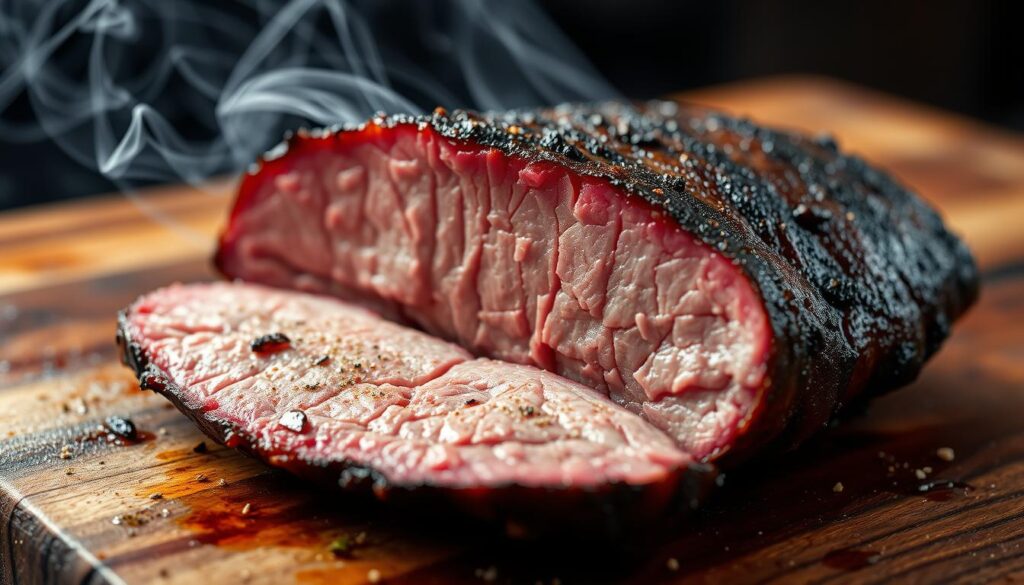
| Factors Affecting Smoke Ring Formation | Impact |
|---|---|
| Moisture content in the meat | High moisture helps smoke and nitrogen-based compounds penetrate the meat, resulting in a deeper and more vibrant smoke ring. |
| Wood type used for smoking | Different wood types, such as hickory or oak, can produce varying levels of nitric oxide, affecting the smoke ring formation. |
| Cooking temperature and duration | Higher temperatures and longer cooking times can enhance the chemical reactions that create the smoke ring. |
Bark Formation: Achieving the Perfect Crust
Making the perfect barbecue bark is like an art. It’s all about controlling browning, caramelization, and moisture. This crust adds a nice texture and brings out amazing flavors, making your barbecue better.
Browning and Caramelization
The secret to a tasty bark is the Maillard reaction and caramelization. When meat gets hot, sugars and amino acids on the surface react. This makes the meat brown and adds flavors like savory, nutty, and sweet.
Crust Texture: Crispy or Sticky?
What kind of crust you like is up to you. It’s about finding the right balance between dry and moist. A crispy bark needs careful moisture control, letting the surface dry and caramelize. For a sticky crust, keep it moist for a glossy look.
To get the crust you want, pay attention to how you cook and baste your meat. Try different rubs and sauces to find the best mix for your barbecue.
“The perfect bark is the culmination of a lifetime of barbecue mastery, where every element – from the rub to the cooking technique – comes together in harmonious perfection.”
Timing is Everything: When to Mop or Spritz
Timing is key when making delicious flavor layers on grilled or smoked meats. Knowing the best mopping and spritzing times helps achieve perfect crust formation and temperature considerations.
Start basting your meat once it starts to form a crust. This usually happens after 30-45 minutes of cooking, depending on the meat’s size and type. Mopping too early can mess up the bark. Waiting too long can leave your meat dry and flavorless.
- Mop or spritz your meat every 30-45 minutes after the initial crust has set, being careful not to remove too much of the rendering fat and juices.
- Pay close attention to the temperature of your grill or smoker, adjusting as needed to maintain the ideal environment for crust formation.
- Experiment with different mopping and spritzing intervals to find the perfect rhythm for your specific recipe and cooking setup.
Mastering when to mop and spritz will help you make the most flavorful and visually stunning smoked or grilled meats your guests have ever had.
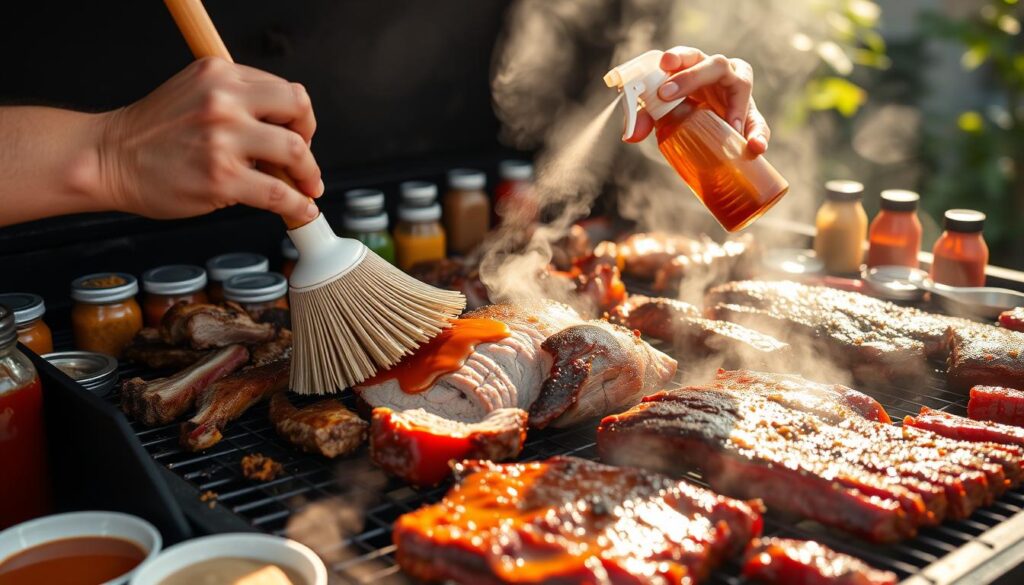
“The secret to the perfect bark lies in the rhythm of your mop or spray bottle.”
Mopping vs. Spritzing: Pros and Cons
Choosing between mopping and spritzing can change how your barbecue tastes and how long it cooks. Both methods have their own benefits and things to think about. Let’s look at what makes each one special to help you pick the best for your meal.
Flavor Impact
Mopping puts a liquid directly on the meat, giving it strong flavors. This method is great for those who want a bold taste. On the other hand, spritzing uses a spray bottle to add flavor. It gives a light, even taste and a nice smell to the meat.
Cooking Time Considerations
How long it takes to cook is important when deciding between mopping and spritzing. Mopping can make cooking longer because the meat absorbs the liquid. This is good for tougher meats that cook better slowly. Spritzing doesn’t slow down cooking much because the liquid evaporates fast, keeping the cooking time steady.
Choosing between mopping and spritzing depends on what you like, the dish you’re making, and what flavor and cooking time you want. Try both methods to see which one works best for your grilling or smoking. This will improve your mopping vs. spritzing experience.
Food Safety: Avoiding Contamination
When you’re basting your meat, keeping it safe is key. If you don’t handle it right, harmful microbes can get back onto the meat. This can make your food unsafe. Here are some important steps to follow for food safety:
- Keep the meat at the right temperature. This kills harmful foodborne pathogens. It’s crucial when you use marinades or sauces with raw meat.
- Keep raw and cooked meats apart. Use different utensils and surfaces for each. This stops bacteria from spreading.
- Clean and sanitize everything you use for basting. This keeps microbes away and stops them from growing.
- Throw away any basting liquid that touched raw meat. Make a new batch to keep your meat safe.
By following these steps, you can make your food taste great without risking anyone’s health.
| Best Practices for Safe Basting | Benefits |
|---|---|
| Maintain Strict Temperature Control | Kills foodborne pathogens and ensures food safety |
| Separate Raw and Cooked Meats | Prevents cross-contamination |
| Regularly Clean and Sanitize Equipment | Eliminates the risk of microbe growth and spread |
| Discard Contaminated Basting Liquids | Promotes meat pasteurization and food safety |
These easy steps will make sure your basting makes your food taste better without risking anyone’s health.
Conclusion
Mastering the art of flavor layers is key to grilling and smoking success. By learning about basting techniques, you can create amazing aromas and tastes. Try different liquids and seasonings to match your taste and cooking style.
Improving your meats’ smoky flavor or achieving a crispy crust is possible with the right barbecue techniques. The journey of mastering grilling is exciting. Enjoy the process and show off your cooking skills with every delicious bite.
You now have the knowledge to make your backyard BBQs unforgettable. Use your new skills to impress everyone. Start this tasty journey and let your love for great barbecue be seen.
FAQ
What are the benefits of basting meat with mops, sprays, and sauces?
Basting your meat adds flavor and aroma. It also removes excess spices or marinades. This can slightly reduce shrinkage and extend cooking time.
How do I create the perfect mop sauce?
To make the perfect mop sauce, pick your ingredients carefully. Use juices, vinegars, spirits, and other liquids for unique flavors. Balance sweet, savory, and spicy tastes.
How can I use mops and sauces to build complex, multi-dimensional flavors?
Use mops and sauces to add layers of flavor from start to finish. Experiment with ingredients and techniques to create your unique barbecue style.
What is the significance of the smoke ring, and how can I achieve it?
The smoke ring adds to your barbecue’s flavor and look. It forms through a chemical reaction in the meat, helped by moisture and smoke.
How can I achieve the perfect barbecue bark?
Creating a flavorful bark is key to great barbecue. Learn about the browning and caramelization processes. Balance moisture for the bark you like.
When is the best time to apply mops or sprays?
Apply mops or sprays after the meat starts to crust. This helps the bark form well and adds moisture and flavor effectively.
What are the differences between mopping and spritzing, and when should I use each technique?
Mopping and spritzing affect your barbecue’s flavor and cooking time differently. Choose the method that fits your dish and preferences best.
How can I ensure food safety when basting my meat?
Be careful with basting to avoid food safety issues. Make sure you’re not adding harmful microbes back onto the meat. Always use clean tools and keep temperatures right.

